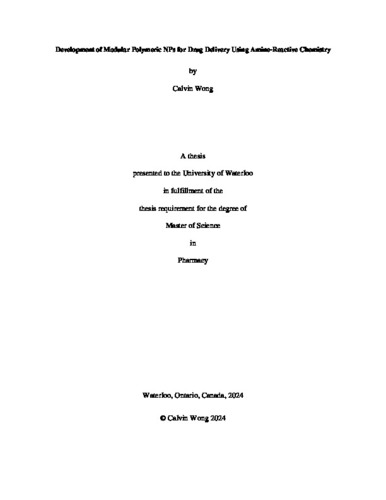| dc.description.abstract | Cancer remains one of the leading causes of death worldwide and very often requires chemotherapy treatment. Despite advances in chemotherapy treatments, some cancers remain difficult to treat due to tumour type, location, and in some cases, the development of drug resistances. In order to tackle cancer more effectively, researchers have explored and developed novel chemotherapy agents. However, many of these agents suffer from low bioavailability or prohibitively high toxicity to the body. Nanotechnology-based drug delivery systems aim to assist in protection and site-specific delivery of these potential anti-cancer agents, increasing their effectiveness and lowering toxic effects. Polymeric NP delivery systems can encapsulate drugs and be coated with functional groups or moieties to enhance various properties such as targeting.
In this project, poly(lactic-co-glycolic) acid (PLGA ) NPs were synthesized to encapsulate curcumin (CUR) via single emulsion method. CUR, the principal constituent of Curcuma longa, commonly known as turmeric, has been explored for its anti-cancer potential, but is severely limited by its hydrophobicity and sensitivity to light and water. The PLGA NPs were coated with oligomeric chitosan (COS) and RGD peptide (peptide consisting of Arg-Gly-Asp) using amine-reactive chemistry (NHS and EDC). Both COS and RGD had been previously shown to accumulate and target many different types of cancer cells. NPs were characterised based on size distribution, zeta potential, and binding efficiency of RGD peptide. They were also evaluated on encapsulation efficiency, and stability, of CUR within the NPs. OVCAR-3 cancer cells were treated with COS and RGD-coated PLGA NPs loaded with Coumarin-6 dye for fluorescent imaging of cell uptake. They were also treated with CUR-loaded NPs to determine cytotoxicity and effectiveness of delivery.
The NPs exhibited size distribution and zeta potential within expected values, though binding efficiency of RGD was low. CUR-loaded NPs showed significant increase in cytotoxicity over free (unencapsulated) CUR, and void (empty) NPs, suggesting successful delivery of CUR as an anti-cancer agent; the performance of COS and RGD coated NPs over bare PLGA NPs was inconclusive, however. Optimization will be required to improve formulation during the coating steps. Further investigation may be required into alternative binding chemistry, such as click chemistry. | en |

